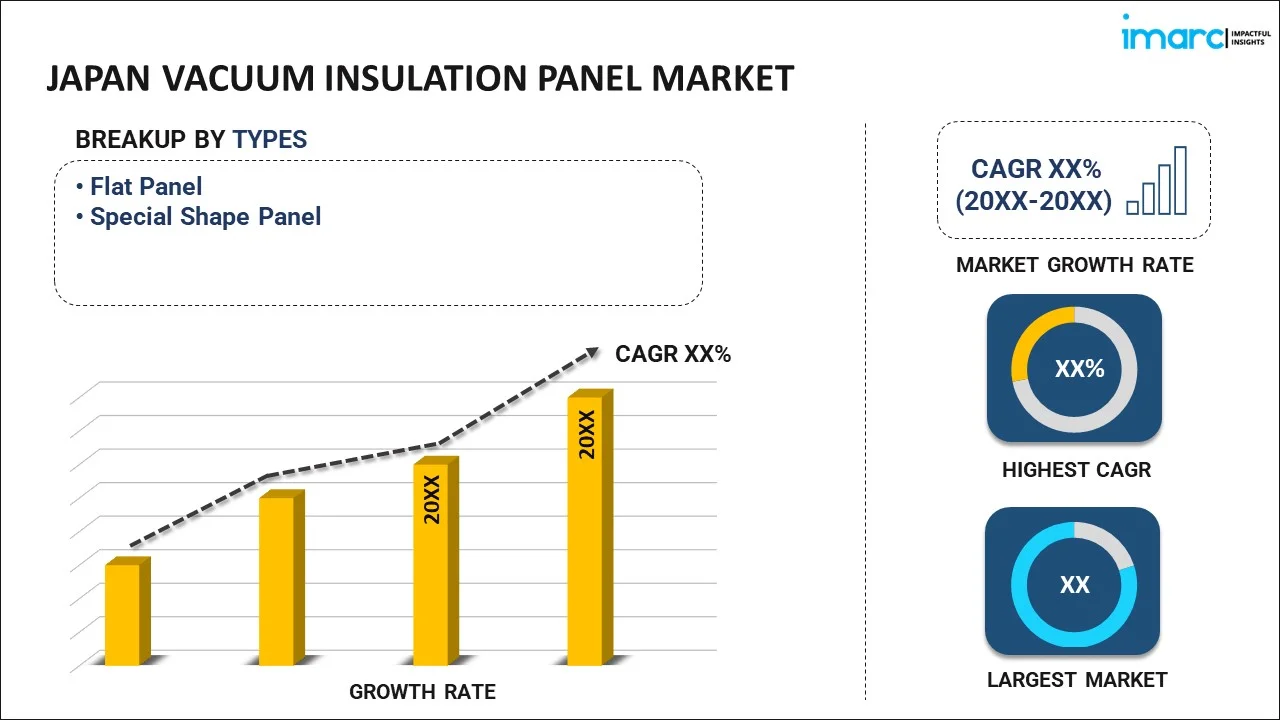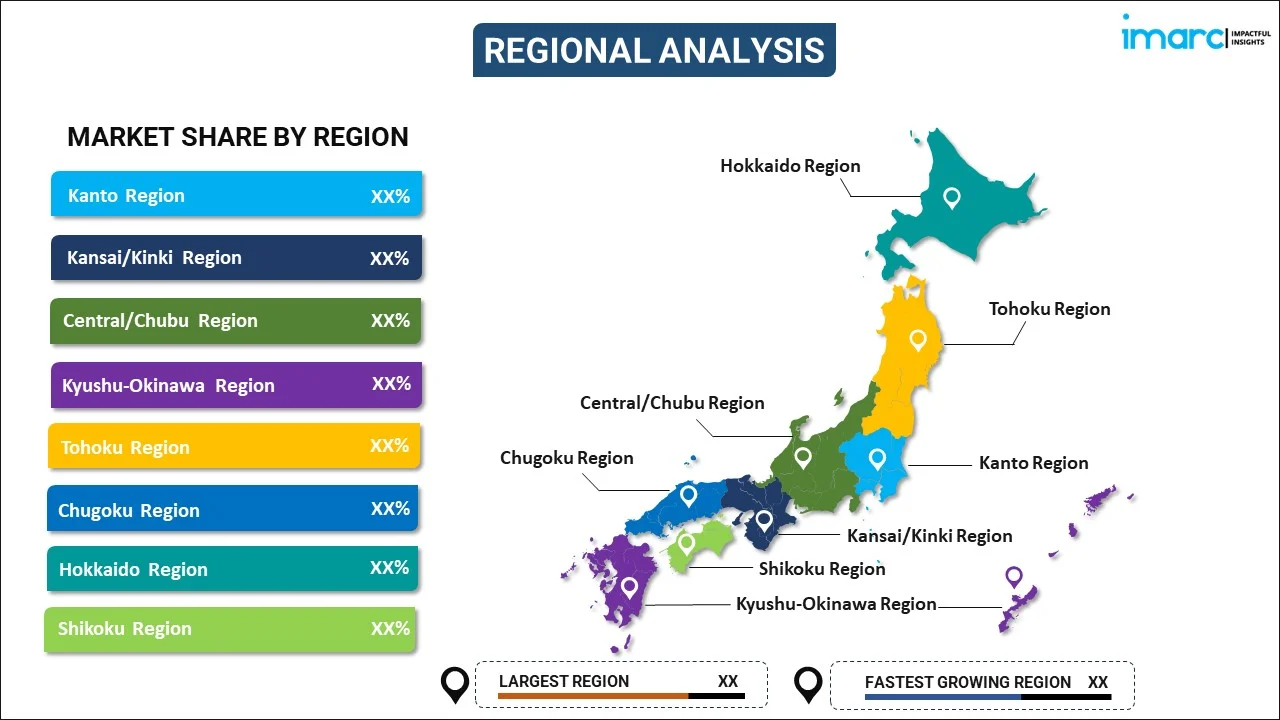
Japan Vacuum Insulation Panel Market Report by Type (Flat Panel, Special Shape Panel), Raw Material (Plastics, Metal), Core Material (Silica, Fiberglass, and Others), Application (Construction, Cooling and Freezing Devices, Logistics, and Others), and Region 2025-2033
Market Overview:
Japan vacuum insulation panel market size reached USD 561.8 Million in 2024. Looking forward, IMARC Group expects the market to reach USD 849.7 Million by 2033, exhibiting a growth rate (CAGR) of 4.7% during 2025-2033. The expanding logistics and transportation industry, particularly in the food and pharmaceutical sectors, which relies on vacuum insulation panels to maintain temperature-sensitive products at the required conditions during storage and transportation, is driving the market.
|
Report Attribute
|
Key Statistics
|
|---|---|
|
Base Year
|
2024 |
|
Forecast Years
|
2025-2033
|
|
Historical Years
|
2019-2024
|
| Market Size in 2024 | USD 561.8 Million |
| Market Forecast in 2033 | USD 849.7 Million |
| Market Growth Rate (2025-2033) | 4.7% |
A vacuum insulation panel (VIP) is an advanced thermal insulation technology designed to minimize heat transfer and maintain temperature stability within a confined space. Unlike traditional insulation materials like fiberglass or foam, VIPs consist of a core material, often a rigid foam or aerogel, enclosed within an airtight barrier, typically made of metal or plastic. The key to their exceptional insulating properties lies in the vacuum created within the panel. By removing air molecules from the core material's surrounding space, VIPs virtually eliminate heat conduction and convection, two primary modes of heat transfer. This creates an extremely efficient insulation barrier that can be significantly thinner than conventional insulation materials while providing the same or even better thermal performance. VIPs find applications in various industries, including construction, refrigeration, and transportation, where maximizing thermal efficiency and space-saving are essential. Their compact design and outstanding insulation capabilities make VIPs an attractive choice for energy-efficient building construction and maintaining temperature-sensitive products during storage and transit.
Japan Vacuum Insulation Panel Market Trends:
The vacuum insulation panel market in Japan is experiencing robust growth due to several key drivers. Firstly, increased awareness of energy efficiency and sustainability has driven demand for advanced insulation solutions. Consequently, consumers and industries alike are seeking VIPs as an efficient means to reduce energy consumption and greenhouse gas emissions. Moreover, stringent building regulations and energy efficiency standards have further propelled the VIP market. Builders and architects are increasingly incorporating VIPs into construction projects to meet these stringent requirements, thereby boosting market growth. Additionally, advancements in material science and manufacturing technologies have made VIPs more affordable and accessible. This, in turn, has expanded their application across various industries, including construction, logistics, and automotive, thereby fueling market expansion. Furthermore, the regional push for better thermal insulation in refrigeration and cold chain logistics to maintain temperature-sensitive products during transportation and storage is expected to drive the vacuum insulation panel market in Japan during the forecast period.
Japan Vacuum Insulation Panel Market Segmentation:
IMARC Group provides an analysis of the key trends in each segment of the market, along with forecasts at the country level for 2025-2033. Our report has categorized the market based on type, raw material, core material, and application.
Type Insights:

- Flat Panel
- Special Shape Panel
The report has provided a detailed breakup and analysis of the market based on the type. This includes flat panel and special shape panel.
Raw Material Insights:
- Plastics
- Metal
A detailed breakup and analysis of the market based on the raw material have also been provided in the report. This includes plastics and metal.
Core Material Insights:
- Silica
- Fiberglass
- Others
The report has provided a detailed breakup and analysis of the market based on the core material. This includes silica, fiberglass, and others.
Application Insights:
- Construction
- Cooling and Freezing Devices
- Logistics
- Others
A detailed breakup and analysis of the market based on the application have also been provided in the report. This includes construction, cooling and freezing devices, logistics, and others.
Regional Insights:

- Kanto Region
- Kansai/Kinki Region
- Central/ Chubu Region
- Kyushu-Okinawa Region
- Tohoku Region
- Chugoku Region
- Hokkaido Region
- Shikoku Region
The report has also provided a comprehensive analysis of all the major regional markets, which include Kanto Region, Kansai/Kinki Region, Central/ Chubu Region, Kyushu-Okinawa Region, Tohoku Region, Chugoku Region, Hokkaido Region, and Shikoku Region.
Competitive Landscape:
The market research report has also provided a comprehensive analysis of the competitive landscape. Competitive analysis such as market structure, key player positioning, top winning strategies, competitive dashboard, and company evaluation quadrant has been covered in the report. Also, detailed profiles of all major companies have been provided.
Japan Vacuum Insulation Panel Market Report Coverage:
| Report Features | Details |
|---|---|
| Base Year of the Analysis | 2024 |
| Historical Period | 2019-2024 |
| Forecast Period | 2025-2033 |
| Units | Million USD |
| Scope of the Report | Exploration of Historical Trends and Market Outlook, Industry Catalysts and Challenges, Segment-Wise Historical and Future Market Assessment:
|
| Types Covered | Flat Panel, Special Shape Panel |
| Raw Materials Covered | Plastics, Metal |
| Core Materials Covered | Silica, Fiberglass, Others |
| Applications Covered | Construction, Cooling and Freezing Devices, Logistics, Others |
| Regions Covered | Kanto Region, Kansai/Kinki Region, Central/ Chubu Region, Kyushu-Okinawa Region, Tohoku Region, Chugoku Region, Hokkaido Region, Shikoku Region |
| Customization Scope | 10% Free Customization |
| Post-Sale Analyst Support | 10-12 Weeks |
| Delivery Format | PDF and Excel through Email (We can also provide the editable version of the report in PPT/Word format on special request) |
Key Questions Answered in This Report:
- How has the Japan vacuum insulation panel market performed so far and how will it perform in the coming years?
- What has been the impact of COVID-19 on the Japan vacuum insulation panel market?
- What is the breakup of the Japan vacuum insulation panel market on the basis of type?
- What is the breakup of the Japan vacuum insulation panel market on the basis of raw material?
- What is the breakup of the Japan vacuum insulation panel market on the basis of core material?
- What is the breakup of the Japan vacuum insulation panel market on the basis of application?
- What are the various stages in the value chain of the Japan vacuum insulation panel market?
- What are the key driving factors and challenges in the Japan vacuum insulation panel?
- What is the structure of the Japan vacuum insulation panel market and who are the key players?
- What is the degree of competition in the Japan vacuum insulation panel market?
Key Benefits for Stakeholders:
- IMARC’s industry report offers a comprehensive quantitative analysis of various market segments, historical and current market trends, market forecasts, and dynamics of the Japan vacuum insulation panel market from 2019-2033.
- The research report provides the latest information on the market drivers, challenges, and opportunities in the Japan vacuum insulation panel market.
- Porter's five forces analysis assist stakeholders in assessing the impact of new entrants, competitive rivalry, supplier power, buyer power, and the threat of substitution. It helps stakeholders to analyze the level of competition within the Japan vacuum insulation panel industry and its attractiveness.
- Competitive landscape allows stakeholders to understand their competitive environment and provides an insight into the current positions of key players in the market.
Need more help?
- Speak to our experienced analysts for insights on the current market scenarios.
- Include additional segments and countries to customize the report as per your requirement.
- Gain an unparalleled competitive advantage in your domain by understanding how to utilize the report and positively impacting your operations and revenue.
- For further assistance, please connect with our analysts.
 Inquire Before Buying
Inquire Before Buying
 Speak to an Analyst
Speak to an Analyst
 Request Brochure
Request Brochure
 Request Customization
Request Customization




.webp)




.webp)












